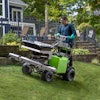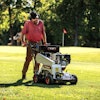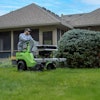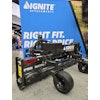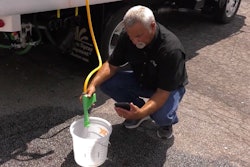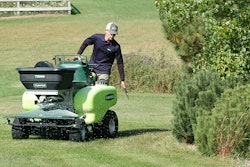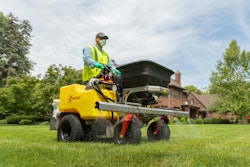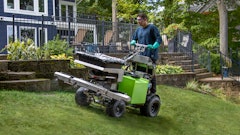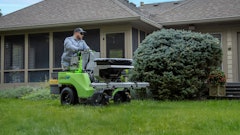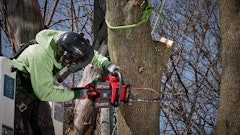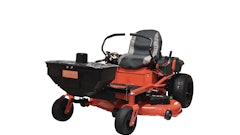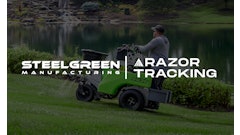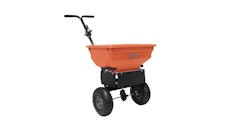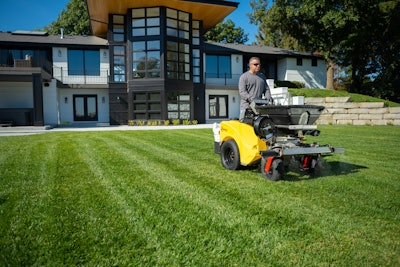
There are many ways to apply fertilizers and chemicals to lawns. Push spreaders and backpack sprayers or truck-mounted tanks with hoses used to be the standard tools for applicators. However, today the stand-on spreader-sprayers have entered the scene.
Why? Because stand-on spreader-sprayers are fast, productive and profitable machines to use. That being said, there are a variety of different spreader-sprayer types, so it’s important to choose the right machine for your needs.
Benefits of stand-on spreader-sprayers
Productivity. One of the most significant benefits of stand-on spreader-sprayers is the ability to apply both granular and liquid materials simultaneously in each pass. By performing (and billing for) two jobs at once, lawn care operators dramatically increase the productivity and profit potential of each applicator. Stand-on spreader-sprayers enable each worker to do more with less. Today, with labor availability being one of the industry’s biggest challenges, that’s especially important.
Profitability. Because stand-on spreader-sprayers are very often the most productive way to apply materials to lawns and other turf areas, crews can finish more jobs each day. There’s less wear and tear on you and your crew as well, so it’s more sustainable day after day. It all adds up to increased profit at the end of the day, and especially at the end of the season.
Versatility. With the ability to apply a wide range of both liquid and granular materials, modern stand-on spreader-sprayers are incredibly versatile. Plus, most leading machines have a wide range of accessories that allow lawn care operators to customize the machine’s capabilities for their specific needs. Including foam markers, light kits, auxiliary/isolated tanks and pumps, more often than not, buyers customize their stand-on spreader-sprayers in some way right off the showroom floor.
Safety. Since the operator stands on a platform, above the lawn, stand-on spreader-sprayers reduce the potential for operator contact with the materials being applied. This makes for an overall safer work environment for applicators when compared to traditional walk-behind or handheld equipment.
Spreader-sprayer types
Most modern stand-on spreader-sprayers can be broken into two types, and the difference boils down to how the machine is steered. Spreader-sprayers with steerable front wheels, or a pivot in the middle of the frame, are the first type, while the second type are zero-turn spreader-sprayers. Ultimately, the choice of which is right for you boils down to lawn care operators' needs and also to a certain extent their budget. There’s not one clear-cut best type of stand-on spreader-sprayer, so let’s take a deeper look at what each type does well.
Zero-turn spreader-sprayers. Most zero-turn spreader-sprayers use a drivetrain setup that’s similar to a zero-turn mower, consisting of hydraulic pumps and wheel motors powering the rear wheels, with pivoting caster wheels at the front. As a result, the value proposition of zero-turn spreader-sprayers is also similar to mowers, with enhanced maneuverability and speed, enabling users to make quick work of big application jobs.
Zero-turn spreader-sprayers often have larger hoppers and tank capacities than steerable models, enabling them to do more work between fillups. Most zero-turn spreader-sprayers use a boom-type spray mechanism to precisely apply materials.
Steerable spreader-sprayers. While steerable spreader-sprayers don’t have zero-turn capabilities, they can still be the best machine for a lot of application jobs, especially if you’re focused on residences. Typically focused on the smaller end of the size scale, many steerable spreader-sprayers are able to fit through a 36-inch gate, obviously a big benefit.
Also, because steering is a function of turning the wheels, the wheels are always in unison. This provides additional hillside stability compared to zero-turn models.
Purchase considerations
Plan for tomorrow. Even if you’re just getting your application program started as a service offering, it makes sense to purchase equipment that will be able to keep up as more and more clients come on board. Of course, your spreader-sprayer should meet your immediate needs, but don’t forget to think about where you want to be in two to three years and buy equipment that can grow and adapt with you.
Buy quality equipment from a dealer you trust. Modern stand-on spreader-sprayers are pretty complex machines, so it makes sense to purchase high-quality equipment from a dealer you have a good relationship with. The dealer is your gateway to not only the parts and accessories you’ll want to make your machine your own, but they can also help ensure you operate it safely. You’ll be up and running faster, with less equipment downtime down the road.
Take a test drive. It’s important not just for your spreader-sprayer to meet your needs, it should also be a machine you and your crew like to use. Controls and control layouts vary from brand to brand, so by test driving, or demoing the machines you’re considering, you can quickly feel if it’s right for you. You want spreader and spray controls to be simple, logical, and easy to reach without compromising your speed or direction control.
The bottom line
Whether you’re just getting started or are looking to take your program to the next level, there’s a stand-on spreader sprayer that can help you get there profitably. Much like any piece of equipment, the decision of which spreader-sprayer is right for you comes down to your needs, your goals and your preferred user experience. There are no wrong answers.
Pro tips
- Calibration is everything when it comes to using spreader-sprayers. If you don’t properly calibrate your machine, you risk overapplying or underapplying product without even knowing it. For precise application rates, it’s crucial to calibrate both the liquid and granular systems on your spreader-sprayer. — Matt Smith, co-founder and sales manager, Steel Green
Spreader-sprayers are inherently efficient machines, but there are several ways to make them work even harder for you. One is tank mixing, which allows you to apply multiple liquid products at one time. Just be sure to read and follow the labels of the products you’re mixing. You can customize the liquid and granular capacity of your machine to reflect how much of your business is liquid versus granular. Also, look into adding an independent tank if you need the ability to make separate chemical applications with your machine. — Smith
- Another way to use your spreader-sprayer more efficiently is to customize it with attachments and accessories specific to the services you offer. In terms of accessories to customize your spreader-sprayer, look for options that align with the services you offer. — Smith
Maintenance should include blowing your spreader-sprayer off daily and applying an anticorrosion product regularly. It’s also important to winterize the spray system to prevent corrosion and clogs. There’s some additional maintenance if you’re using the machine with a plow in the winter, including snow tires for improved traction. — Smith

